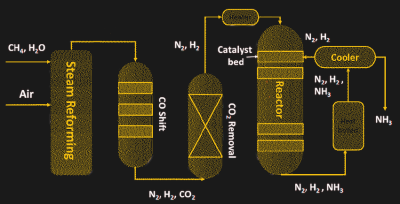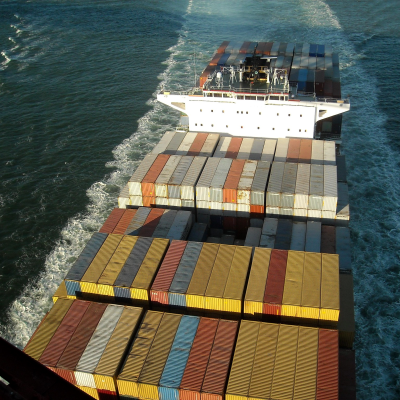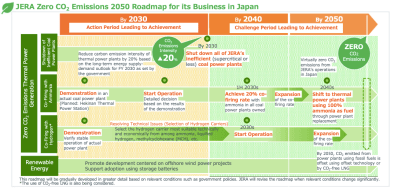
With climate change concerns front of mind, the world is desperate to get to net-zero carbon output as soon as possible. While direct electrification is becoming popular for regular passenger cars, it’s not yet practical for more energy-intensive applications like aircraft or intercontinental shipping. Thus, the hunt has been on for cleaner replacements for conventional fossil fuels.
Hydrogen is the most commonly cited, desirable for the fact that it burns very cleanly. Its only main combustion product is water, though its combustion can generate some nitrogen oxides when burned with air. However, hydrogen is yet to catch on en-masse, due largely to issues around transport, storage, and production.
This could all change, however, with the help of one garden-variety chemical: ammonia. Ammonia is now coming to the fore as an alternative solution. It’s often been cited as a potential way to store and transport hydrogen in an alternative chemical form, since its formula consists of one nitrogen atom and three hydrogen atoms.However, more recently, ammonia is being considered as a fuel in its own right.
Let’s take a look at how this common cleaning product could be part of a new energy revolution.
A Clean Burn
Like hydrogen, ammonia is flammable. It also contains no carbon, so it doesn’t produce carbon dioxide during combustion. It has much better energy content by volume, almost double that of hydrogen, though only a third as much as diesel. It’s also much easier to store than hydrogen; it is liquid at just -33°C, compared to liquid hydrogen that must be stored at -253°C. Plus, ammonia doesn’t have the same storage problem as hydrogen, which can creep out through tiny gaps in almost any material, often damaging them in the process.

The concern is around getting this fuel cleanly. Currently, ammonia is made using the Haber-Bosch process, which combines hydrogen and nitrogen to make ammonia. Fossil fuels are typically used as a source of hydrogen. In a process called steam reformation, methane from natural gas is turned into hydrogen, but the process comes with significant carbon dioxide emissions. In fact, ammonia production currently makes up about 1% of global carbon emissions.
Green ammonia is the solution, where the hydrogen is instead supplied in a cleaner fashion. This typically involves using hydrogen that is generated by splitting water with renewable energy sources like wind power or solar power. This allows the production of ammonia with far less carbon dioxide emitted, which would otherwise ruin its potential as a cleaner fuel.
For Shipping
The shipping industry is responsible for 2.5% of global carbon dioxide emissions. Efforts have long been trying to reduce the emissions footprint of shipping across the board, and ammonia could be the latest tool in that fight.

Unfortunately, ammonia’s unique combustion properties mean that it’s not a drop-in replacement for existing marine fuels. These typically include diesels and heavy fuel oils used to run giant, low-speed reciprocating engines, though liquified natural gas is becoming popular as a slightly greener alternative.
Thus, efforts are being made to develop marine engines that can use ammonia as a fuel. MAN has developed a two-stroke marine engine that runs on ammonia, and plans are already in place to use the engine to power tankers as well as bulk carriers and container ships. The company is working on a retrofit package to allow older ships to run on ammonia, too.
Ammonia does present some unique challenges outside of the engine itself, too. Thanks to its lower energy density compared to diesel, a ship that would conventionally use a 1,000 m3 fuel tank would instead need 2,755 m3 to go as far using ammonia instead. However, it still beats out hydrogen or batteries as potential options, which would require 4,117 m3 and 14,000 m3 to store the same energy respectively.
As with most new fuels, there’s also the problem of infrastructure. Few to no ports currently offer bulk ammonia as fuel, and it’s not really practical to send your ship’s mate down to the local supermarket to pick up thousands of bottles of cleaning product to run the engine. However, if ammonia engines work well in practice, there’s every chance it will catch on, and for the shipping industry to begin a push towards mainstream use of the cleaner fuel.
For Power Plants

Japan is exploring the use of ammonia as a co-burning fuel for coal power plants. The intention is to add 20% ammonia content by calorific value to fuel in these plants in order to reduce carbon emissions. As with many other cleaner fuel projects, starting with a blend is less technologically challenging, and also eases the pressure on supply chains. The technology will go into testing in 2023, and it’s hoped the 20% blended fuel will be ready for practical use by 2025. In the longer term, it’s hoped 100% ammonia combustion could be used for power generation, but that goal is set for 2040 or beyond.
A zero-carbon fuel for power generation would be a useful tool to back up renewable sources of energy that aren’t available around the clock. However, ammonia combustion does still create nitrogen oxides, and thus it’s not as clean as options like solar and wind power.
Using ammonia for power generation will increase Japan’s demand for the chemical significantly. Japan only used 1.1 million tons of ammonia in 2019. To meet the goal of 20% co-combustion with ammonia, set for the mid-2030s, Japan would need 20 million tons of ammonia a year. That’s approximately the total amount of ammonia currently traded on the global market, so simply buying more isn’t an option.
Plans are in place to scale up to 3 million tons in the domestic supply chain by 2030. Intentions are to push that up further to 30 million tons by 2050. Much will likely be imported from overseas, with industry exploring options to build new terminals to ship in hundreds of thousands of tons a year by sea.
Looking To The Future
If ammonia is to catch on as a cleaner fuel for the future, several dominoes must fall in its favor. Massive production facilities must be rolled out to produce ammonia cleanly and from renewable energy sources. Storage and shipping infrastructure must follow, and the fuel’s performance must be borne out in the real world. It would also need to be cost competitive with renewable energy options like direct electric from solar and wind, which is a difficult call in the grid power space.
However, humans feel familiar and safe when it comes to burning fuels for energy, and there are great practicalities to liquid fuels that alternative solutions are still yet to match. Ammonia could thus turn out to be a star in humanity’s march to a cleaner energy future.
Banner photo: “Osaka Japan” by Pedro Szekely
Japan Wants to Decarbonize With The Help of Ammonia
Source: Manila Flash Report
0 Comments